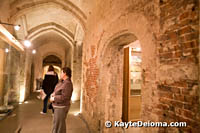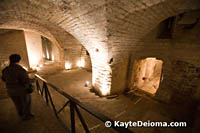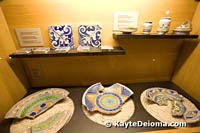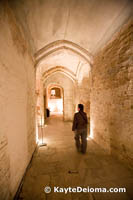story and photos by Kayte Deioma
 One of Brussels’ most striking landmarks is the Atomium, a giant iron atom that towers over the Heysel Plateu. The 390 foot structure, designed by engineer André Waterkyn, was built for the 1958 International Exposition of Brussels. Like the Eiffel Tower, it was planned as a temporary attraction, but due to popular demand, became a permanent part of the Brussels landscape. A recent renovation, completed in 2006, restored the steel globes to their original splendor.
One of Brussels’ most striking landmarks is the Atomium, a giant iron atom that towers over the Heysel Plateu. The 390 foot structure, designed by engineer André Waterkyn, was built for the 1958 International Exposition of Brussels. Like the Eiffel Tower, it was planned as a temporary attraction, but due to popular demand, became a permanent part of the Brussels landscape. A recent renovation, completed in 2006, restored the steel globes to their original splendor.
Although there are temporary exhibits mounted in some of the globes, the main attraction is the structure itself. From an architectural and engineering standpoint, as well as from a purely aesthetic view, to put it in sophisticated terms, it’s really cool!
is the structure itself. From an architectural and engineering standpoint, as well as from a purely aesthetic view, to put it in sophisticated terms, it’s really cool!
You get your tickets in a separate little building before entering the Atomium.
 There are nine spheres connected by 20 tubes. There’s an elevator straight up the middle which will take you to the snack bar in the middle sphere and the casual restaurant at the top. Each tube is only wide enough for either one escalator or a staircase, so to visit the side globes, you follow the escalators up, and take the stairs back down the other side.
There are nine spheres connected by 20 tubes. There’s an elevator straight up the middle which will take you to the snack bar in the middle sphere and the casual restaurant at the top. Each tube is only wide enough for either one escalator or a staircase, so to visit the side globes, you follow the escalators up, and take the stairs back down the other side.
 You start your visit by taking the elevator to the top to check out the panoramic view over the neighboring Mini-Europe at the Bruparck to the alternating old and new neighborhoods and stretches of green parks that make up greater Brussels. The observation floor and the restaurant above it are in the only globe with windows giving you the 360 degree panoramic view. Interactive monitors help to orient you to what you are seeing in the distance.
You start your visit by taking the elevator to the top to check out the panoramic view over the neighboring Mini-Europe at the Bruparck to the alternating old and new neighborhoods and stretches of green parks that make up greater Brussels. The observation floor and the restaurant above it are in the only globe with windows giving you the 360 degree panoramic view. Interactive monitors help to orient you to what you are seeing in the distance.
 Three of the spheres below have exhibit space. A permanent exhibit features giant photos of some of the key players in the construction and a great 12 minute silent video documenting the construction of the Atomium. The other two areas have changing exhibits.
Three of the spheres below have exhibit space. A permanent exhibit features giant photos of some of the key players in the construction and a great 12 minute silent video documenting the construction of the Atomium. The other two areas have changing exhibits.
The Children’s Sphere is used for school groups < who can come and spend the night as part of an educational program. The domed upper portion of the sphere is filled with smaller turquoise and red globes suspended from the ceiling. Each one has a slice out of the side and room for several kids to crawl into the cubby hole onto the round mattress piled with pillows. Unfortunately, this room is not open to the public, so you can only look through the window.
who can come and spend the night as part of an educational program. The domed upper portion of the sphere is filled with smaller turquoise and red globes suspended from the ceiling. Each one has a slice out of the side and room for several kids to crawl into the cubby hole onto the round mattress piled with pillows. Unfortunately, this room is not open to the public, so you can only look through the window.
From the Atomium a pedestrian bridge leads across the freeway to the Bruparck, a combination theme park and entertainment complex. One of its attractions is Mini-Europe, a collection of European landmark buildings from the Acropolis to Big Ben and the Eiffel Tower built at 1/25 scale. The Bruparck is also home to the Océade, an indoor/outdoor water park; Kineopolis, a 24 screen movie theater;and The Village, a collection of restaurants, bars and shops.
The Atomium
Square de l’Atomium
1020 Brussels
32 (0) 2 475 4775
www.atomium.be
Metro line A1 to Heysel station

 There’s something irresistible about a city as devoted to comic strips as Brussels. There are no less than four museums devoted to the history, the creators and the production of the bande dessinée or comic strip. There are over a dozen stores specializing in comic books and merchandise, and even a comic-themed bar. As if that weren’t enough, you can see larger than life comic statues and murals of some of the most popular characters all around town.
There’s something irresistible about a city as devoted to comic strips as Brussels. There are no less than four museums devoted to the history, the creators and the production of the bande dessinée or comic strip. There are over a dozen stores specializing in comic books and merchandise, and even a comic-themed bar. As if that weren’t enough, you can see larger than life comic statues and murals of some of the most popular characters all around town. It’s not the American classics like Peanuts and Superman, or Japanese animé, but home-grown creations like Tintin, the Smurfs and hundreds of others that have filled the pages of Belgian newspapers, magazines and comic books for a century. Belgium, as it turns out, has more comic strip authors per square mile than anywhere else in the world.
It’s not the American classics like Peanuts and Superman, or Japanese animé, but home-grown creations like Tintin, the Smurfs and hundreds of others that have filled the pages of Belgian newspapers, magazines and comic books for a century. Belgium, as it turns out, has more comic strip authors per square mile than anywhere else in the world. The strategically placed comic strip characters look a bit out of place in the elegant lobby with its stone columns and wrought iron grillwork supporting a frosted glass ceiling embellished with stained glass ribbons around the edges. Through an opening in the center you can see the upper floors and skylight above. Along with the restaurant and Art Nouveau gallery, a gift shop, reading room and research center surround the atrium. A marble-based lamp post stands in the center, and a wide stairway leads up to the ticket desk and official entrance to the museum.
The strategically placed comic strip characters look a bit out of place in the elegant lobby with its stone columns and wrought iron grillwork supporting a frosted glass ceiling embellished with stained glass ribbons around the edges. Through an opening in the center you can see the upper floors and skylight above. Along with the restaurant and Art Nouveau gallery, a gift shop, reading room and research center surround the atrium. A marble-based lamp post stands in the center, and a wide stairway leads up to the ticket desk and official entrance to the museum. The first hall behind the ticket counter introduces you to the original technologies used to create and print comic strips as well as the team of writers, artists, colorists, letterers and printers whose efforts go into producing the final product. Publishers, marketers and merchandisers have their roles as well.
The first hall behind the ticket counter introduces you to the original technologies used to create and print comic strips as well as the team of writers, artists, colorists, letterers and printers whose efforts go into producing the final product. Publishers, marketers and merchandisers have their roles as well. In the Espace Saint Roche gallery, the museum presents rotating exhibits from their collection of over 7,000 original comic strip drawings. On the opposite side, Comic Strips in Motion shows the evolution from comic strips to animated cartoons from Little Nemo, the first animated cartoon in 1911, to modern digital animation technology.
In the Espace Saint Roche gallery, the museum presents rotating exhibits from their collection of over 7,000 original comic strip drawings. On the opposite side, Comic Strips in Motion shows the evolution from comic strips to animated cartoons from Little Nemo, the first animated cartoon in 1911, to modern digital animation technology. The Smurf Museum exhibit tells the tale of the “intrepid Professor De Saeger” who found the mystical land of the little blue “Schtroumphs” and brought back these artifacts to prove their existence. The display includes original line drawings and paints and well as Smurf toys and a “scale model of a Smurf dwelling.”
The Smurf Museum exhibit tells the tale of the “intrepid Professor De Saeger” who found the mystical land of the little blue “Schtroumphs” and brought back these artifacts to prove their existence. The display includes original line drawings and paints and well as Smurf toys and a “scale model of a Smurf dwelling.” The printed English guide is invaluable for understanding the significance of the permanent collection if you don’t read French or Dutch. If you want to get the most out of the museum but you don’t want to do all that reading, you might want to hire an English-speaking guide. They are available by appointment only and charge a flat rate for up to 25 people for a one and a half hour tour. Guides are also available to take you on a walking tour of the outdoor Comic Strip Trail.
The printed English guide is invaluable for understanding the significance of the permanent collection if you don’t read French or Dutch. If you want to get the most out of the museum but you don’t want to do all that reading, you might want to hire an English-speaking guide. They are available by appointment only and charge a flat rate for up to 25 people for a one and a half hour tour. Guides are also available to take you on a walking tour of the outdoor Comic Strip Trail. The saying “One man’s trash is another man’s treasure,” could be the motto of the field of archaeology, where a broken pottery shard, a flint or a chicken bone can elicit more excitement than discovering gold. The archaeologists hit the jackpot in Brussels when new construction in 1995 revealed that the lower levels of the Royal Palace on Coudenberg Hill which burned down in 1731, were left largely intact when they flattened the area in 1774 to build a new royal compound. After a six-year excavation, the restored underground passages were opened to the public in 2001.
The saying “One man’s trash is another man’s treasure,” could be the motto of the field of archaeology, where a broken pottery shard, a flint or a chicken bone can elicit more excitement than discovering gold. The archaeologists hit the jackpot in Brussels when new construction in 1995 revealed that the lower levels of the Royal Palace on Coudenberg Hill which burned down in 1731, were left largely intact when they flattened the area in 1774 to build a new royal compound. After a six-year excavation, the restored underground passages were opened to the public in 2001. and a street that ran along the outside of the palace give a glimpse of the support system for the Archdukes, and Duchesses, Princes and Emperors who resided here.
and a street that ran along the outside of the palace give a glimpse of the support system for the Archdukes, and Duchesses, Princes and Emperors who resided here. Part of the chapel cellar now houses an exhibit of the artifacts discovered in the excavation. 16th century chamber pots, book clasps and random utensils were recovered from the cesspools. Heater tiles and a plethora of architectural remains and everyday items were found in the rubble of the Grand Hall. One display case contains a colorful collection of broken bits of 16th century majolica architectural tiles, dinner plates and apothecary vessels.
Part of the chapel cellar now houses an exhibit of the artifacts discovered in the excavation. 16th century chamber pots, book clasps and random utensils were recovered from the cesspools. Heater tiles and a plethora of architectural remains and everyday items were found in the rubble of the Grand Hall. One display case contains a colorful collection of broken bits of 16th century majolica architectural tiles, dinner plates and apothecary vessels. palace’s most famous resident, Charles V, the simultaneous King of Spain, Emperor of Germany and Sovereign of the Low Countries, came to be first emancipated and later abdicated his throne in Brussels.
palace’s most famous resident, Charles V, the simultaneous King of Spain, Emperor of Germany and Sovereign of the Low Countries, came to be first emancipated and later abdicated his throne in Brussels.